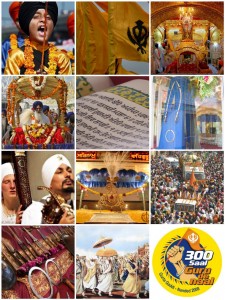
UPDATE: If you are outraged by this incident, please CALL THE HARRIS COUNTY SHERIFF’S OFFICE (TEXAS) @ (713-755-6044) and let Harris County Sheriff Tommy Thomas know how you feel. These Officers need to be reprimanded and we as a community need to push the Sheriff’s Office to act. You can also contact Houston Mayor Bill White at (832-393-1000) or mayor@cityofhouston.net.
The night before Thanksgiving you are robbed of your sense of security and $15,000 of your home belongings AND THEN you are robbed of your humanity by Sheriff’s Officers who promise to protect you. All this happens in your own home …
The Tagore family in Texas were criminalized and terrorized because of their Sikh articles of faith after calling in to report a burglary in their home.
Ramandeep Singh Tagore says,
“That night we were actually robbed twice … Once by the actual burglars, who we don’t know who they were, and secondly by the Sheriff’s Department, who we knew who they were.”
Once the Sheriff’s Officers had arrived in their home they started focusing on Kawaljeet Kaur’s kirpan and told her: “You can’t wear that”, she felt like she was being treated “ … like a criminal in my own home … “. Kawaljeet Kaur [Ramandeep Singh Tagore’s sister] told the Houston News that “I didn’t appreciate the way that I was treated that day … I’m a human and I would have expected to be treated like a human.” Kawaljeet verbalized her feelings and constitutional right to practice her faith to the Officers. Their response was pushing her out of her house, having her sit in the middle of the street, and handcuffing her.
Ramandeep said to Harpreet Kaur of Sach Productions (watch the video below for more in-depth reporting)
“first we are calm and then the aggression … brutality type of thing … pushing and shoving is starting when the cops get here I mean their acting like thugs … if we are civilizingly dealing with them then why do you have to come push me and shove me when we’re trying to talk to you … is it because I look different or something.”
Manjit Kaur, Ramandeep’s mother, felt: “Dekhoo ik taan saade ghar robbery hoyi hai ..tusi lok saadi help karan aaye aan k saanu arrest karan aaye aan” (Look there has been a robbery in our house … have you people [Sheriff’s Officers] come to help us or arrest us?)
I spent the past weekend surrounded by Sikh Art and Film at the annual Spinning Wheel Film Festival in Hollywood. I usually attend these events with high expectations, hoping to be inspired and moved and there are always one or two films that provide that sustenance. The films were creative, such as The Making of Liverpool – an artistic animation inspired by a painting by The Singh Twins which explores 800 years of Liverpool’s history. The films were educational, such as Cultural Safari – directed by Sandeep Singh and produced by the Kaur Foundation – describing the basics of Sikhi for children of all ages [I have to say that this is one of the most impressive educational films I have come across]. The films were also daunting, such as Warrior Boyz – made by Baljit Sangra which touched upon the root causes of gang violence in the Punjabi community of Vancouver. A favorite of the crowd was Kuldip Powar’s Unravelling – a poetic inter-generational dialogue between the film director and his grandfather about the experience of war all posed in Urdu poetry.
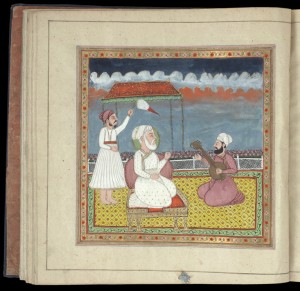 There were many other well-made films such as 35, Kabaddi Cops, and Right to Turban which rightfully deserve mention (and have been discussed or will be discussed in future posts), however what I appreciated most about the weekend was the final day of the festival – which was devoted to lectures on Sikh Art and History. Staff from the Anglo Sikh Heritage Trail and other UK-based organizations presented the attendees with a glimpse into the historical legacy of the Sikhs. One of the lectures was titled the Epic of Saragarhi and discussed the 21 soldiers of the Sikh regiment who defended a remote post against an estimated 10,000 hostile tribesmen. Michael O’Keefe from the British Library discussed Sikh artifacts and paintings and detailed an image of Maharani Jindan Kaur’s Gutka of the Sukhmani Sahib (see picture to the left). The day ended with a panel showcasing Sikhs in Theatre and Music, including traditional music and also hip-hop. Mandeep Sethi and Jagmeet Singh, rappers from LA, ended the festival with amazing performances showcasing their incredible talent of telling stories through hip-hop.
There were many other well-made films such as 35, Kabaddi Cops, and Right to Turban which rightfully deserve mention (and have been discussed or will be discussed in future posts), however what I appreciated most about the weekend was the final day of the festival – which was devoted to lectures on Sikh Art and History. Staff from the Anglo Sikh Heritage Trail and other UK-based organizations presented the attendees with a glimpse into the historical legacy of the Sikhs. One of the lectures was titled the Epic of Saragarhi and discussed the 21 soldiers of the Sikh regiment who defended a remote post against an estimated 10,000 hostile tribesmen. Michael O’Keefe from the British Library discussed Sikh artifacts and paintings and detailed an image of Maharani Jindan Kaur’s Gutka of the Sukhmani Sahib (see picture to the left). The day ended with a panel showcasing Sikhs in Theatre and Music, including traditional music and also hip-hop. Mandeep Sethi and Jagmeet Singh, rappers from LA, ended the festival with amazing performances showcasing their incredible talent of telling stories through hip-hop.
While the film festival brought together a plethora of Sikh art mediums – what it did seem to be missing was the representation of women and the voice of women in these films. The films were predominately made by men and the issues discussed were predominately issues affecting men. This brought several issues to mind – do young Sikh women not feel encouraged to enter the field of Film? Do the current male Sikh filmmakers not feel comfortable telling the story of Sikh women? It seems to be of vital importance that as we develop and promote Sikh films, we ensure that the stories we tell are representative of the entire Sikh panth and pay particular attention to the stories of Sikh women.
I will leave with this quote, mentioned by Harbinder Singh of the Anglo Sikh Heritage Trail, but also very pertinent to the theme of this weekend’s film festival.
Until lions tell their own history,
History will always glorify the hunters.
– African Proverb
In a recent THL discussion on Prop. 8 we have been addressing the use of Sikh principles in taking a position on homosexual marriage.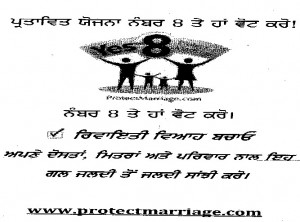 At a recent Nagar Keertan in Yuba City, California there were “Yes on Prop. 8” fliers along with the really interesting T-shirts. Thus, I think religion is an important part of the discussion on Prop. 8 because there is a reason why this state-related material is at religious events. Religion is a moral compass that guides many people’s decisions in all kinds issues. Thus, I don’t condemn those who have used religion as their moral source for voting Yes or No on Prop. 8. However, I do disagree with how Sikh scripture has been misused as “rules” rather than concepts that guide our decisions. I attribute these actions to a general lack of understanding and education around the Guru Granth Sahib Ji in our community. This education is a fundamental issue we as a Quam need to find practical solutions for rather than blame people for not knowing.
At a recent Nagar Keertan in Yuba City, California there were “Yes on Prop. 8” fliers along with the really interesting T-shirts. Thus, I think religion is an important part of the discussion on Prop. 8 because there is a reason why this state-related material is at religious events. Religion is a moral compass that guides many people’s decisions in all kinds issues. Thus, I don’t condemn those who have used religion as their moral source for voting Yes or No on Prop. 8. However, I do disagree with how Sikh scripture has been misused as “rules” rather than concepts that guide our decisions. I attribute these actions to a general lack of understanding and education around the Guru Granth Sahib Ji in our community. This education is a fundamental issue we as a Quam need to find practical solutions for rather than blame people for not knowing.
That said, I believe a fundamental part of Sikhi is love … the morality of love. It’s not the happy happy love or perfect one that excuses all actions, but the one that makes us human enough to see the light of Waheguru in all …. even those we detest. What is this love … I think Khalil Gibran poignantly explains it in his book “The Prophet”:
“For even as love crowns you so shall he crucify you. Even as he is for your growth so is he for your pruning. Even as he ascends to your height and caresses your tenderest branches that quiver in the sun, so shall he descend to your roots and shake them in their clinging to the earth.”
The elections are over, but even after the last card has been punched and the last absentee ballot counted, the political fervor that they ignited is still alive. While the country took two steps forward on its march towards complete civil rights by electing its first African American president , it took a step back by taking away the rights of particular individuals. California’s Prop. 8 received national attention (no surprise with more than $70 million in campaign spending). The proposition reversed a ruling from the California Supreme Court, which earlier this year declared that banning same-sex marriages was discriminatory. Prop. 8 – which passed albeit by a hair – will for the time being change the state constitution to define marriage as only between a man and a woman.
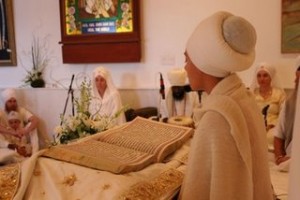 People feel really passionate about this topic. Really really passionate. What interests me the most, however, are the arguments for and against same-sex marriages and particularly what it does or does not say in the Sri Guru Granth Sahib about this topic. People are actually using words from the Sri Guru Granth Sahib to make their point – and I’m not sure that’s legit. In fact, I’ve been following a heated discussion on a certain social networking site where young Sikh individuals have been going back and forth about what voting for or against Prop. 8 means. The most common argument against same-sex marriages is that in the Sri Guru Granth Sahib it states that marriage is the union of two souls, husband and wife, man and woman, male and female. The other side of the argument is that Sikhi advocates equal rights for all and the Sri Guru Granth Sahib does not specifically make any comment on same-sex marriages. However, there seems to be a lot of ambiguity as to what is actually said. One reference states,
People feel really passionate about this topic. Really really passionate. What interests me the most, however, are the arguments for and against same-sex marriages and particularly what it does or does not say in the Sri Guru Granth Sahib about this topic. People are actually using words from the Sri Guru Granth Sahib to make their point – and I’m not sure that’s legit. In fact, I’ve been following a heated discussion on a certain social networking site where young Sikh individuals have been going back and forth about what voting for or against Prop. 8 means. The most common argument against same-sex marriages is that in the Sri Guru Granth Sahib it states that marriage is the union of two souls, husband and wife, man and woman, male and female. The other side of the argument is that Sikhi advocates equal rights for all and the Sri Guru Granth Sahib does not specifically make any comment on same-sex marriages. However, there seems to be a lot of ambiguity as to what is actually said. One reference states,
[The Sri Guru Granth Sahib] is seemingly silent on the subject of homosexuality; however, married life is encouraged time and time again in Guru Granth Sahib Ji. Whenever marriage is mentioned, it is always in reference to a man and a woman. Some Sikhs believe that Guru Granth Sahib Ji is the complete guide to life, and if a marriage between two of the same sexes is not mentioned, it is therefore not right. The counterargument to this is that man and woman are only mentioned in this way to give light to the relationship of the soul and the soul force as being one. This denies gender and sex as an issue. Thus, Sikhism is more concerned with ones attainment of enlightenment rather than habitual desires such as sexuality. True love is attained through the Guru and no man speaks on behalf of the Guru as the Granth is open to interpretation and misrepresentation. [Link]
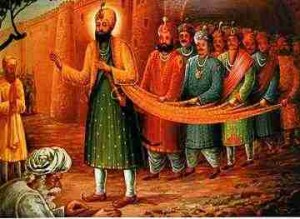 Many Sikhs participate in the celebrations of Diwali, the festival of light, without actually knowing what the significance of the date is in Sikh history. I can admit that for a long time, Diwali didn’t hold much importance for me because I didn’t fully understand why we celebrated it. In fact, today is not only Diwali but also marks Bandi Chor Diwas a day where Sikhs join together to celebrate the release of the sixth Nanak, Guru Hargobind Ji from imprisonment. The historic event itself should be acknowledged with significance – particularly the fact that upon order of his release from Gwalior Fort, Guru Hargobind Ji refused to leave unless the 52 princes who had also been imprisoned would also be allowed to leave. Thinking of others’ rights were more important than simply thinking of his own.
Many Sikhs participate in the celebrations of Diwali, the festival of light, without actually knowing what the significance of the date is in Sikh history. I can admit that for a long time, Diwali didn’t hold much importance for me because I didn’t fully understand why we celebrated it. In fact, today is not only Diwali but also marks Bandi Chor Diwas a day where Sikhs join together to celebrate the release of the sixth Nanak, Guru Hargobind Ji from imprisonment. The historic event itself should be acknowledged with significance – particularly the fact that upon order of his release from Gwalior Fort, Guru Hargobind Ji refused to leave unless the 52 princes who had also been imprisoned would also be allowed to leave. Thinking of others’ rights were more important than simply thinking of his own.
To me, the day is a reminder of the concept of Sarbat da Balla, or the welfare of all. Sarbat da Balla is a guiding principle that hopefully makes our words and actions bring about positive change to the greater good. As we approach the upcoming election (7 days to go!), it is these principles that should help advise us on those issues that affect not just ourselves but the collective good. While the economy is the principal concern on the minds of most voters, healthcare is an important issue that will also sway votes in a meaningful way.
A recent Kaiser Family Foundation poll shows that voters agree that in the face of a struggling economy “it is more important than ever to take on health care reform.”
Among Democrats, expanding coverage for the uninsured ranks second, named by 35 percent of those voters. Coverage also ranks second for political independents, named by a somewhat smaller proportion (23 percent). Relatively few Republicans (9 percent) name coverage as a health care priority. Most Democrats (69 percent) and half of independents (51 percent) think that universal coverage would help the overall economic situation in the United States, while only 34 percent of Republicans agree. [link]
Some ideas are just better communicated through modes other than writing. Theatre, through the unfolding of a story and through the body language of its actors, can sometimes convey meaning and ideas more effectively than just written words alone.
Some Sikh youth from Rockland, MD have decided to use theatre to engage non-Sikhs in learning about Sikhs- a wonderful idea.
Two plays are being planned for the fall expressing themes of diversity, mutual respect, interfaith and justice. They will both be staged on Saturday December 13, 2008 at the Wooten High School in Rockville, Maryland.
Where did this idea come from?
Last fall, Guru Gobind Singh Foundation had some of its kids take part in a play The Lorax, a musical adaptation from the famous Dr Seuss story book which was staged by kids from many different faiths. This play, adopted to create awareness about environment, was coordinated by the Interfaith Conference of Metropolitan Washington and was staged by the Children’s Theater Company of New York.
After going through this experience, GGSF decided to form the Rockville Chapter of Children’s Theater Company last May to explore the possibility of staging a play depicting the concepts of Guru Granth Sahib. Dedicated to “Building Character Onstage”, the Children’s Theatre Company (CTC) of New York develops in children and youth a keen sense of citizenship while introducing them to the incomparable magic of theatre through their full participation in the creation and performance of musicals and plays. [link]
Over the next few weeks Sikhs will join together to celebrate the 300th anniversary of the Sri Guru Granth Sahib. Just like many of you, I’ve been reading articles and stories about the various celebrations and I’ve come across some amazing and enriching images showing how the concepts of Sangat, Seva, and Guru come together. So I thought that in place of writing a post for once – I would instead create a mosaic of some of the images I have come across which represent the celebrations in one way or another. Pictures really do speak louder than words. [You can click on the image for a closer look].
For the uninitiated Panthic Weekly is a Sikh portal that provides news and media on various issues that affect the Sikh community. As part of the Panthic Network, my first memories of the team are related to the long-standing Fort Panth Khalsa that especially became popular during the debates centered around the then-Jathedar Ranjit Singh.
The website over the years has developed a formidable presence on the website and is a celebrated by that section of our community that have a leaning towards the strong opinionated slant it represents, especially towards a specific Jathabandi.
For the most part, I applaud Panthic Weekly’s efforts and their abilities to engage with youth audiences with a variety of media. Their Khalsa.tv, Panthic.fm, Kathaa.net and Keertan.net are all efforts that deserve praise.
However, my problem with the network is their derogatory language and uncivil discussions that are promoted, often bordering on bullyism. Whenever, the editors of Panthic Weekly do not like a person, they change their name from ‘Singh’ to ‘Sinh’. Parkash Singh Badal becomes Parkash Sinh Badal; Former Jathedar Darshan Singh Ragi becomes Darshan Sinh Ragi; Prime Minister Manmohan Singh becomes Manmohan Sinh. Allegations of RAW agent, RSS-stooge, “traitor”, etc. and the worst parts of our post-1984 history are relived where Sikhs spew vitriole on other Sikhs.
Only every so often I come across a petition in my inbox which advocates for an issue that I feel strongly about. I find myself more than happy to take the few minutes required to click on the links and add my name to the “Undersigned.” 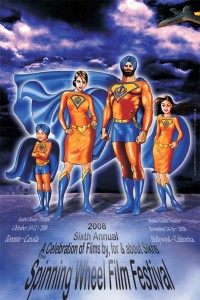 A few days ago, I was sent another such petition, but to be quite honest I didn’t quite know what to make of it.
A few days ago, I was sent another such petition, but to be quite honest I didn’t quite know what to make of it.
The petition, drafted in response to an advertisement for the upcoming Spinning Wheel Film Festivals, states that the “superhero” image being used depicts Sikhs in a negative manner. The author(s) suggest that the characters shown in the poster are portrayed in ways that go against the Sikh Rehat Maryada and Gursikh principles.
The current poster diminishes Sikh identity by playing fast and loose with Sikh Rehat Maryada in presenting the lead male and female characters as superheroes and role models. They appear more as villains, abandoning the true Sikh virtues. Going about “saving the world” with the hair uncovered is far from being obedient to Sikh Rehat and to the visible identification as a Gursikh. The Kirpan is supposed to be worn in a Gatra, not attached to a belt. Furthermore, pierced ears as in the case of the young girl are not in the spirit of how Sikhs should raise their children towards principled Sikh living.
I have my own opinions about the SWFF as it stands today, and although I was somewhat surprised by the choice of promotional material being used (from an aesthetic perspective) – I was much more intrigued about the nature and origin of the petition. I don’t know who authored the petition (does it matter?), but it brings up a much larger issue. The petition goes beyond a simple commentary of promotional material. The various comments left on the petition (even the incoherent ones) suggest that many individuals within our community still believe that Sikhs are only defined by certain external attributes:
From the Volokh Conspiracy:
Dear Senator McCain:
Repeatedly calling me and everyone else in the United States “my friends” is extremely annoying. In part, it’s just an irritating phrase. Beyond that, I’m not your friend. I don’t know you, and, from what I know of you, I don’t even really like you. Sorry to focus on such superficialities when the world economy is going to Hell, but you probably lost more votes with your constant repitition of “my friends” than from anything Obama said.
Sincerely,
David B. [link]
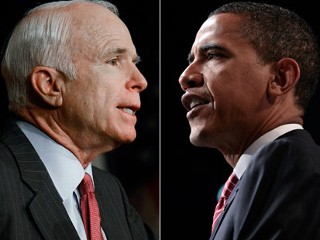 Reema (I’m signing on.)
Reema (I’m signing on.)
Both candidates used the phrase. And of course, because of my bias, it grated on my nerves when McCain used it. It was just amusing when Obama did. Anyone who is about to control my life and the lives of all US residents is not a friend, and they shouldn’t try to be. They just better know what they’re doing because everything (economy, environment- one in 4 mammals is threatened with extinction, social security, Medicare + Medicaid) seems to be falling apart at the same time. Not to be dramatic or anything. The only suggested economic solution from a Sikh point of view I found was vague, overly ambitious, and not really very palatable either.
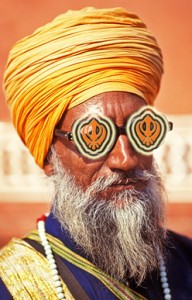 Has anyone else noticed how ridiculous the (US Presidential Election) campaigns have gotten? The ridiculousness has reached a new all time low in the past few weeks with both sides slinging mud, making tenuous connections, and outright lying. Admittedly, I have a preference for one side over the other, but like most people nowadays that means less than it used to and I have truly tried to be “fair” in my analysis of recent politicking. What I have seen from both sides makes me gag.
Has anyone else noticed how ridiculous the (US Presidential Election) campaigns have gotten? The ridiculousness has reached a new all time low in the past few weeks with both sides slinging mud, making tenuous connections, and outright lying. Admittedly, I have a preference for one side over the other, but like most people nowadays that means less than it used to and I have truly tried to be “fair” in my analysis of recent politicking. What I have seen from both sides makes me gag.
It seems to me that the strategies on both sides of the isle amount to this: avoid answering any questions; lie/stretch the truth whenever you feel you can get away with it (or even when you know you can’t), and don’t forget to act arrogant. If you doubt my generalization, I implore you to go to johnmccain.com or barackobama.com and look at the ads for yourself, watch the debates, or just snippets on youtube. What’s even worse is that the media has come to expect this childishness. Some of you may be thinking “So what?! – this is politics.” It is my hope that most of you don’t feel that way and just accept this behavior as the status quo.
I think what gets to me about this whole election cycle is how fundamentally un-Sikh-like the behavior has been. Let me explain. As a Sikh – I like to look at things through my Sikh glasses and when something is fuzzy or just doesn’t make sense, it is time to analyze why. Growing up as a Sikh and trying to live a gursikh life now, I have come to think of certain things – stand up for what you believe in, speak the truth – as almost requirements for being a good person. Gurbani provides numerous references to such virtues and while I am sure they are no different from many other religions, I think they are much more pronounced in the Sikh faith. Integrity, honesty, and courage are central to Sikhi. So from this perspective I evaluate recent campaign tactics.
Ultimately, my point is that the campaigns aren’t making their cases very well to someone like me, who is wearing gold rimmed, khanda shaped, Sikh glasses. Ideally, I’d like a President who I can feel good about, someone I see as a role model, and right now the choices leave much to be desired…
—
By the way, despite the above I feel one of the candidates is at least trying to steer clear of the muck and focus on the issues…so I give props to OBAMA for that. Go OBAMA!
Last week Bill Maher was a guest on the Daily Show, promoting his new movie Religulous and offering a clip. The clip happened to show a sardar in a London park, which was the extent of any Sikh’s appearance in the movie.
The name, ‘Religulous,’ is a portmanteau blending the words 1) religion and 2) ridiculous, and examines the overlap of those concepts. The movie’s proclaimed purpose is to promote doubt in the minds of those who have blocked doubt in religious teachings completely and subsequently hold totally irrational beliefs (i.e. reject evolution), though those who actually go to watch the movie probably wouldn’t be completely opposed to such doubt to be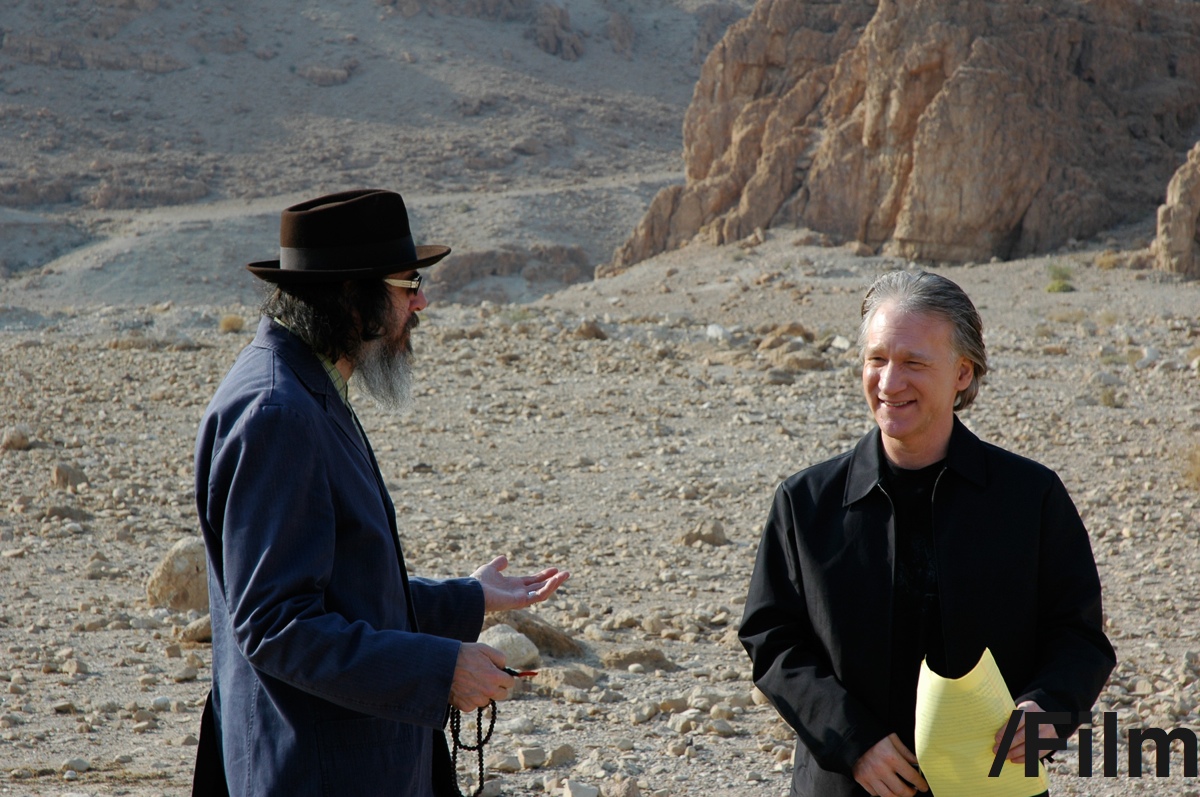 gin with. Of course at some point the explanations of rationality end, and there is the unknown. The point of the movie is to admit that it actually is unknown, and show that those who claim to know, really don’t.
gin with. Of course at some point the explanations of rationality end, and there is the unknown. The point of the movie is to admit that it actually is unknown, and show that those who claim to know, really don’t.
In the movie, Bill Maher interviews people from a variety of backgrounds and religious faiths (from a former head of the Human Genome Project and the former Director of the Vatican observatory to a British rapper). Some hold more nuanced views than others. He listens and asks questions of people who staunchly believe in literal translations of age old texts even when their beliefs scientifically absurd, and has some interesting (and comical) conversations. My favorite interview by far was with a very rational Vatican priest who happily admitted that Jesus’ birthday is not on December 25th and the Catholic church has absolutely no idea when it really is.
Time magazine recently named Balbir Singh Seechewal amongst its “Heroes of the Environment 2008.” The acknowledgement highlights the work of activists such as Balbir Singh and shows how their passion and innovation can positively impact the environment. Balbir Singh is described as “the Sikh who cleans the corrupted rivers of India,” and he is accoladed for his work of cleaning the historic Kali Bein river. The 99-mile-long river, in the Hoshiarpur district, is considered historically significant because Guru Nanak Dev Ji was said to have received enlightenment after taking a dip in the Kali Bein river. However, due to years of neglect, the river has become a containment of waste,
Over the past couple of decades it was reduced to a filthy drain into which six towns and more than 40 villages emptied their waste. Parts of the river dried up, leaving neighboring farmlands parched. Its polluted waters also seeped underground, contaminating the groundwater and causing lethal diseases.
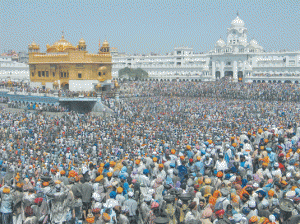 In 2000, Balbir Singh and inspired volunteers decided to use the concept of kar seva (voluntary service) to physically clear the entire riverbed and build riverbanks and roads alongside the river. In addition, they educated the locals via a public-awareness campaign on how to keep the river clear of waste. Today the river is not only cleared of sewage, but the natural springs have been revived and the river is once again flowing.
In 2000, Balbir Singh and inspired volunteers decided to use the concept of kar seva (voluntary service) to physically clear the entire riverbed and build riverbanks and roads alongside the river. In addition, they educated the locals via a public-awareness campaign on how to keep the river clear of waste. Today the river is not only cleared of sewage, but the natural springs have been revived and the river is once again flowing.
As we join others in praising Balbir Singh and his volunteers for what they have accomplished with the Kali Bein river, I also want to highlight the concept of Kar Seva and take the liberty to ask if we do enough of it? The most famous examples of Kar Seva occurred at the Darbar Sahib in Amritsar. I have seen pictures and videos of the last Kar Seva which occurred in Amritsar – and I have to admit, I don’t think words can describe the power of those images.
We seem to be pre-occupied with building new gurdwaras (yes, I know – that’s a whole other issue), but i mention it to simply say that as a community, we don’t do a very good job at sustaining our current establishments. Whether we speak of our historic gurdwaras in Punjab (both East and West Punjab) or if we think about our gurdwaras here in North America – there is a lot of Kar Seva which can be done. After seeing the images of Kar Seva at the Darbar Sahib, it is amazing to me how our community can mobilize itself to such an extent and peform such an incredible act. And yet, in many communities and at many gurdwaras, we struggle with keeping the kitchen clean or the trash picked up. Can Kar Seva exist outside of Punjab? It just makes you wonder….
Often on this blog we have discussed what role our institutions should play in our lives and recently I had an opportunity to examine the issue anew. In a recent gurdwara council meeting I attended, one gurdwara decided to give a large sum of money to a group putting on a bhangra program. The group was not affiliated with the gurdwara. I will admit, I did not say anything at the time because I do not attend the gurdwara that decided to do this, but the incident did get me thinking about gurdwara funds and the concept of daswand.
When a gurdwara collects funds from the sangat – it does so under the pretence that the money is being collected to be put to some higher use, a use that we ourselves could perhaps not put it to, whether it be spiritual or practical. Usually we give the money as part of our daswand or some random seva to the gurdwara, but I think in every case it is understood that we are giving the money up to be put to a use that our Guru’s would have used it for – something necessary, something practical, and fundamentally “good.”
And as I write this post, some questions that I haven’t even answered for myself come to mind – Is the daswand I give to the gurdwara something I have a right to control – can I decide where it goes? If Sikhi is to be treated like a democracy, I would argue that absolutely I have every right to “vote” on where the funds go or at least have a chance to say something. But even in such a vote – should there be limits? Shouldn’t the funds of a gurdwara be spent on activities, which embody Sikh ideals and values? Presently, I am inclined to believe that sangat should have a say in where gurdwara funds are spent, but also that the options for spending funds should be limited to projects that actually embody and promote Sikh ideals.
But back to where we started – I brought bhangra up because it is something that can be debated – I’m not contending that it is an anti-Sikh activity, but at the same time, I don’t really think bhangra is something that perpetuates the Sikh way of life either. So I guess the dilemma in my mind in determining where the gurdwara should be spending its funds and where to draw the line…
Heads-up friends, the season of the “Spinning Wheel Festival” is about to begin across North America this autumn. Celebrating Sikh films and art, the first stop will be in New York City on Saturday, October 04, 2008 at the Asia Society & Museum (p.s. that’s next Saturday). Buy your tickets NOW! The wonderful Rabbi Shergill will be performing at the opening gala (yes I am really biased here … I heart Rabbi Shergill) and DJ Rekha will be literally “spinning” at the after party.
Films a the NYC festival will range from documentaries on Pahelwani (i.e. Panjabi wrestling) and Kaba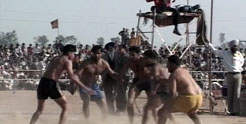 ddi-playing Canadian police officers to issues affecting the Sikh community from 1984 and post-9/11 hate crimes. There will also be short and feature films. For example, one on a young boy’
ddi-playing Canadian police officers to issues affecting the Sikh community from 1984 and post-9/11 hate crimes. There will also be short and feature films. For example, one on a young boy’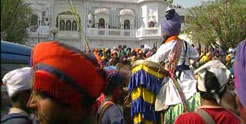 s struggle to keep his hair while his family fears the obstacles he will encounter and another on “… a young Sikh doctor struggling with the inequities of the American Health System and ultimately his own identity”. The Holy Duels of Hola Mohalla is a film looking at the Khalsa Panth.
s struggle to keep his hair while his family fears the obstacles he will encounter and another on “… a young Sikh doctor struggling with the inequities of the American Health System and ultimately his own identity”. The Holy Duels of Hola Mohalla is a film looking at the Khalsa Panth.
The films seem interesting both in content and presentation. The stories are grounded in the realities many of us encounter everyday. You can get a full listing of the films and their synopses here.
In the past, I have attended the “Spinning Wheel Festival” at one of its many North American stops and found it a great space for artists and art-enthusiasts to be exposed to Sikh creativity. I remember there being a panel discussion with the directors and the audience. We don’t have too many of these creative opportunities in our community even though we spend plenty of time and space advertising foreign medical schools in Poland, China, and the Caribbean.
I have found that some films are really hit or miss at these festivals, but it’s expected sense the focus is on cultivating and inspiring creativity; while, building a permanent Sikh film festival for years to come. Cash prizes are awarded to the “bests” in various categories. I have been told that the listing and quality of films varies across the different North American stops.
At the end of the day why not go, especially if it’s close by. I personally think it’s worth a visit as an act of supporting Sikh arts and learning about the various issues affecting our community. Sometimes we get too caught up in our own worlds and don’t realize these issues are taking place or we are in amidst of them and they become normal parts of our lives leaving very little room for reflection or exposure to others’ perceptions. Thus, it’s an  opportunity to get a fresh/new look at various issues.
opportunity to get a fresh/new look at various issues.
Lastly, the arts, from painting and photography to films and music, are our community’s soul! They help us speak in ways we can’t always articulate. So go save your soul and attend a Sikh artistic event! 
Okay, enough of the attempt at convincing … the other North American stops will be:
- Toronto, Canada from October 10-12, 2008 at the Isabel Bader Theatre.
- Hollywood, California from November 14-16, 2008 at the Writers Guild Theatre.
Are ya’ll thinking of going? What have your experiences been at the various Spinning Wheel Festivals? Does anyone know of other North American stops?
p.p.s. The Toronto and Hollywood poster is really interesting isn’t it … a conversation in of itself!
So recently I came across a blog about all the “Stuff Korean Moms Like”. A Korean girl, Chiyo, who loves her KM (Korean Mom) decided to create this blog “to share the joy and dread of KM”. As I went through the list … I kept thinking about our own PSM’s (Panjabi Sikh Moms) … now now don’t think it’s funny to call our mummies’ PMS that actually stands for Panjabi Male Syndrome!
As I went through the list … I kept thinking about our own PSM’s (Panjabi Sikh Moms) … now now don’t think it’s funny to call our mummies’ PMS that actually stands for Panjabi Male Syndrome!
From corningware to marrying people off and stank eye … I found many similarities between KMs and PSMs (although the differences were stark … I don’t even think many PSMs know what redbean is let alone love it. And when it comes to Jesus … let’s just stick with the Gurus and Waheguruji)!
Inspired by Chiyo’s blog on Korean Moms, let’ start our own list of “Stuff Panjabi Sikh Moms’ Like”! I will begin …
- Tupperware (i.e. I am not just talkin’ about Rubbermaid … I mean sour cream and whipped butter dabhaa). Over time this Tupperware becomes yellow from all the haldhee in sabjis … but soak it in the sun and most of the stains go away. Slowly over time old ones are replaced as new ones are collected.
- Corningware (do I really need say anything more … I think Chiyo’s explanation resonates perfectly with PSMs).
- Zee TV, Sony TV, and Alpha Etc. Punjabi nateekhs (what’s your mom’s favorite soap opera …).
- Noon Dhani (i.e. the steel container with small steel bowls and spoons for all their spices).
- Dhahee (i.e. homemade yogurt … sorry I personally can’t stand the boxed stuff after growing up on my mom’s delicious freshly made dhahee).
- Outrage at the rising cost of Ataa (i.e. flour that is commonly bought at the Indian store to make roti).
- House-walls that are painted hospital white … look how clean and simple they look. The rooms feel much more lighted with this color.
- Overstuffing Family And Friends With Food … lai if they leave your house without a food-coma, they did not have a good-time.
- Cooking your favorite Panjabi dish when you come home from college. It’s a sign of how much she missed you.
- The ten Gurus’ pictures, particularly those of Guru Nanak Dev Ji and Guru Gobind Singh Ji, are the number one home-decorating items.
Please add to the list ( it’s in no particular order)! What do you think Panjabi Sikh Mom’s really like? I know many of you must have your own favorites! 
Disclaimer: Please keep it clean, respectful, and hate-free … I really should not have to say this, but unfortunately in the virtual world people often display a “holds-no-bar” attitude when commenting on issues like this one.
Update: wow, I did an AWFUL job of summarizing SRI’s first webinar. (Apologies to the good folks at SRI) Here’s a better summary:
Sikh Theology – A Gurmat Framework: The first session comprised of introducing an approach to Sikhi and recognizing how Guru Nanak Sahib revolutionarily delivered a message of Oneness through illustrating a direct connection between ideas and practice. We engaged in understanding what ‘Guru’ means in the Sikh context and how we can begin to comprehend the Guru’s wisdom, Gurmat. To develop this understanding, three facets of bani (scripture), tavarikh (history) and rahit (lifestyle) were introduced. The greatness of a religion is when harmonious balance between Ultimate reality and visible form is exemplified thru the aforesaid facets. We concluded with Puran Singh’s rendering on the Guru’s vision, “It sweetens you and your sweetness sweetens all life around. At your sight, the lamb and the tiger must drink at the same pool.”
And some info on session 2:
Bani – The Message: In session two, we continued to build on our understanding of the Guru’s message; We engaged in actively learning about the scriptural canon, the Guru Granth Sahib. In covering topics as the compilation, contributors, structure, language and content of Guru Granth Sahib, we tackled questions such as, “How do we know Guru Granth Sahib is the Guru?” and “What is the Sabad Guru?”; thus, facilitating and inspiring us to continue to build our personal relationship with Guru Granth Sahib.
And 3:
Tavarikh – The Revolution: Having concentrated on the written form of our Guru’s message (Bani) last week, this week in session three, “Tavarikh – The Revolution”, we will turn our focus on to how our Gurus exemplified The Message. We will walk through the lives of Guru Nanak Sahib through Guru Gobind Singh Sahib and try to understand them through a social, political, economic and spiritual framework. We will cover a range of issues, from touching on the ramifications of negating the need of a Divine intermediary, to the economic center created by the Guru Sahibs, to the activism of both social and political kind. In surveying the inspiring history of our Gurus, we hope to remind ourselves of how relevant, active and exemplary the revolution of Sikh? is.
Dr. Pashaura Singh, Professor at University of California, Riverside, was recently appointed to its Dr. Jasbir Singh Saini Chair in Sikh and Punjabi Language Studies. However, not without controversy. There have been several incidents since his inception to the Chair where members of the Sikh community have challenged his appointment because of Dr. Singh’s interpretation of the Sikh scriptures.
Sikhs believe the scriptures were revealed to a series of gurus…those revelations in the form of 6,000 hymns were compiled in 1604 by the fifth guru, Guru Arjan, and became the holy scriptures. Pashaura Singh’s thesis and subsequent research are based on a manuscript that surfaced in 1987 that he believes is a draft of the 1,430-page document compiled by Guru Arjan. Singh says the so-called 1245 manuscript, part of the rare book collection at Guru Nanak Dev University, includes sections that are blank and others that have been crossed out, showing evidence of having been edited. [link]
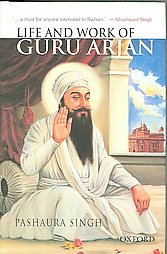 The story goes back many years. Singh, coming from the University of Michigan, was hired in 2005 to teach Sikh and South Asian religious studies. While at that time the chair position was not official, Dr. Singh was recruited with the promise of a potential endowed chair that would provide him with financial support for research. At that time, members of the Sikh community expressed concern about Dr. Singh’s appointment stating his research was problematic and challenged traditional Sikh views. Another issue stemmed from the fact that Ellen Wartella, executive vice chancellor and provost, assured the community in writing that while Singh would teach religious studies “it has been determined that he will not hold this chair.” The community is upset that the university went back on its word.
The story goes back many years. Singh, coming from the University of Michigan, was hired in 2005 to teach Sikh and South Asian religious studies. While at that time the chair position was not official, Dr. Singh was recruited with the promise of a potential endowed chair that would provide him with financial support for research. At that time, members of the Sikh community expressed concern about Dr. Singh’s appointment stating his research was problematic and challenged traditional Sikh views. Another issue stemmed from the fact that Ellen Wartella, executive vice chancellor and provost, assured the community in writing that while Singh would teach religious studies “it has been determined that he will not hold this chair.” The community is upset that the university went back on its word.
Today, members of the Sikh community are still upset about Dr. Singh’s appointment and are arranging a peaceful protest on the university grounds on September 26th, 2008.
The idea that the scriptures were edited or changed is blasphemous to traditional Sikhs. “If this is true, then the revealed word of God is not the revealed word,” said Dr. Baljeet Sahi, an Altadena veterinarian and president of Sikhs for Preservation of Sikhism and Sikh Heritage. Sahi called the 1245 manuscript fraudulent and said it was obtained from a scrap dealer. He said it may have been written by one of the guru’s rivals, who started a parallel tradition after he was denied a guruship. [link]
In the past, several posts have focused on the work of the Sikh Coalition around community mobilization to fight school bullying and the launch of an educational tool. 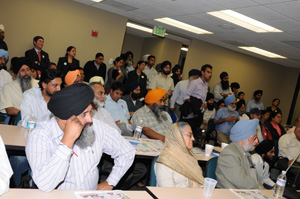 As part of the Sikh Coalition’s on-going work, it has opened a new office in Northern California to provide coast–to-coast civil/human rights advocacy for Sikhs. On September 10th, over 100 attendees, including local community members and politicians, celebrated the Sikh Coalition’s office opening in Fremont, California.
As part of the Sikh Coalition’s on-going work, it has opened a new office in Northern California to provide coast–to-coast civil/human rights advocacy for Sikhs. On September 10th, over 100 attendees, including local community members and politicians, celebrated the Sikh Coalition’s office opening in Fremont, California.
The Coalition’s, Western Regional Director, Neha Singh, said:
“Fremont is nationally the heart of the Sikh community … since we started, we’ve always taken cases from around the country, and a large amount of them were from the Bay Area. We thought it was now time to open an office in an area where a lot of the people requesting our services were.”
This past week, I saw this advertisement about the “GurSikh Speed Meeting.” For those of you who have no idea the Sikhnet’s Gursikh Speed Meeting is obviously (and admittedly) the Sikh version of speed dating. According to the organizers of the program: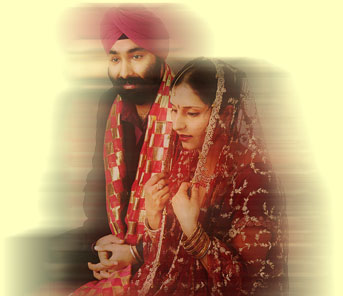
The concept is quite simple. An equal number of Sardars and Sardarnis register. On the event date, each Sardar will meet each Sardarni one-on-one and chat for a specified number of minutes rotating till they have met all the Singhnis. This face to face style of meeting has spurred much interest, in addition to, respecting the participant’s privacy. Only if there is an agreed ‘CLICK’ will an exchange of contact information occur.
I remember when I first saw Sikhnet advertising this a couple of years ago and thinking to myself, “this is bold.” I don’t necessarily think dating for Sikhs is anti-gurmat, but dating is definitely still taboo in A LOT of Punjabi Sikh families.
